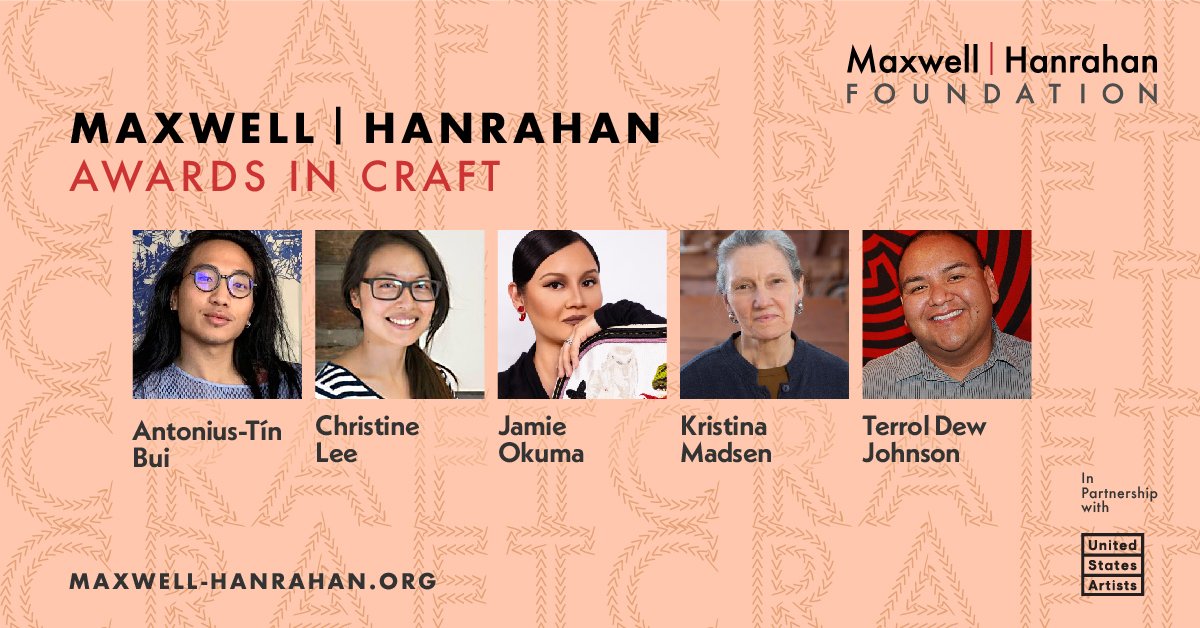Art and Craft at the Foundation
At the Maxwell/Hanrahan Foundation we believe that individuals accomplish amazing things when given meaningful support. We also believe that direct, hands-on connection with one’s subjects can lead to unique insights and work. Problem solving does not always follow a straight path, and exploration and engaging with all one’s senses can sometimes lead to new directions. This notion was the impetus for our Awards in Field Biology program, and it now informs the foundation’s Awards in Craft.
Our Personal Connection to Craft
As an undergraduate at Rhode Island School of Design, I studied textiles and developed a lifelong interest in pattern, the feel of material and thread, and the sumptuousness of color. Discovery of an old jacquard loom run with punch cards led to my interest in computers to create design and pattern. After a career in computer animation and user interface design, I have returned to my love of physical textiles. And I am astonished by the creativity, depth and beauty of textiles from around the world. Each piece reveals insights about its cultural origin and the hands of the individual makers.
Pat has been exploring woodworking, 3D printing and other modern technology in craft making. With his computing students at Stanford he promotes building a creative mindset and culture of making. In one class, “Making Making Machines for Makers,” Pat helps young makers explore new ways of making and building tools and new technology. Some of the best projects his students created included making software for quiltmaking, planting seeds in interesting patterns and building a curvilinear bandsaw. Although we both have engaged with the next frontiers of technology across our careers, we have also found grounding and creative problem solving with our hands.
Learning and Connecting by Making
In addition to engaging with all your senses in exploring materials and creativity, there is also great satisfaction in making something for one’s household, a friend or a family member. What is more precious than a handmade gift, or than an heirloom table made by one’s grandfather? We're witnessing a moment of renewed appreciation for craft in US culture. Many small businesses have been created to supply makers with parts and materials from around the world, and online sites share knowledge and approaches. We recognize that technology alone cannot provide fulfillment or answers. The pandemic has posed both challenges and new opportunities to engage with each other, use our hands and appreciate both the virtual and the physical. And important discussions about culture and lived experience lead us to return to cooking, crafting and making to celebrate traditions and examine how they give meaning to today's world.
American Living Treasures
In Japan, where I lived for a time, master craftspeople, artists and performers may be designated as Living National Treasures, “Preservers of Important Intangible Cultural Properties.” This naming is a way to perpetuate techniques from the past and keep local traditions and skills from being lost. Artists and craftspeople of the highest potential train with a master and seek to be part of the next generation of masters. South Korea and the Philippines have analogous programs.
This training requires working through a lifetime of steps to achieve the needed skills and recognition. Becoming a living treasure does not mean merely replicating styles and techniques from the past, although that may be part of the process. One must also surpass the precedents and create work with one’s own style and sensibility; in this way the work is living and evolving.
Although we don’t intend to replicate this model, we recognize that mastering traditional techniques, working with local materials and culture and always seeking improvement and innovation is a valuable way to think about crafts. In this way we hope to support a cohort of uniquely American living treasures.
Art and Craft at the Foundation
We value the beauty and potential of materials, the mastery of technique and the preservation and evolution of cultural knowledge. We have an expansive definition of craft: We value local and cultural craft traditions while supporting experimentation with new materials and techniques. Craft includes many materials and techniques—the traditional and the yet-to-be discovered.
For the foundation, artistic practice may include the use of materials such as, but not limited to, wood, glass, clay, stone, basketry, textiles and metals. We encourage experimentation with new materials, as well. We value the toolmakers and tradespeople whose inventions extend the field of craft.
We believe that the direct connection to materials triggers a feedback between imagination, technique, intellect and hands. Deep understanding of the characteristics of one’s material can reveal its inherent beauty and value and push it to a new level.
We honor the creators of objects that exhibit the synthesis of form and function as well as objects that push the boundaries between craft and art. We believe more support can and should go to supporting artists and craftspeople, and we encourage others to support them.
Art and Craft Grants
The Maxwell/Hanrahan Awards in Craft will support five individuals with one-time, $100,000 awards to promote the vibrancy of the field, elevate their diverse perspectives and enable them to commit time to exploration and expression. There are no strings attached. These one-time, unrestricted awards support individuals as they grow in their careers and will propel their work forward, foster support for funding art and craft, and encourage others to commit to these fields.
In parallel, we support artists and craftspeople at a different phase and level through scholarships, apprenticeships, and internships at art, craft and trade schools in the US. We also want to provide support at smaller scales and with a quick turnaround to give people the opportunity to learn new skills and to make things. We will likely add programs and projects as we grow this exciting work.
